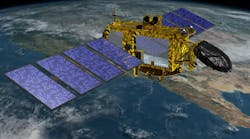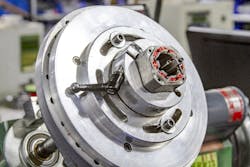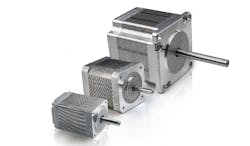Solving Stepper Motor Design Challenges for Space
The harsh environment of vacuum and microgravity applications pose many issues with component capabilities that don’t commonly have to be dealt with here on Earth. That is especially true when it comes to components where movement is their primary function—such as motion control systems. Motors specifically introduce many inherent problems to the environment, mainly due to the fact that they require considerable amounts of power to operate, can generate excessive heat, can introduce unwanted vibrations into the system, and can become a source of contaminants.
Dealing with these issues comes at a substantial cost. Higher power requirements necessitate larger power generation systems, more heat generated requires bigger cooling systems, dealing with unwanted vibrations requires more robust damping systems, and contaminations can cause havoc on instruments and other on-board components. This complexity can translate to potential component or system failures—yet, there is no room for that in space applications, which is why it’s important to work with a company that has a lot of experience with space flight requirements. Specialized space hybrid stepper motors are required to work in harsh environments and accurately deal with the inherent problems of motion control in space. Plus, the motors are assembled in accordance with Aerospace AS9100 standards in a fully compliant facility in California, where each component origin is traceable to maintain strict control over the manufacturing process as well as the final product specifications. But how are these challenges addressed?
Optimized Power Consumption
In space applications, power comes at a premium. Every watt that is wasted by a system that has not been fully optimized for space costs precious resources. Optimizing for power consumption includes customizing motor windings so that they are able to deliver a peak amount of dynamic torque at the desired operating speed—which takes the proper integration of high-precision components, such as low inertia rotors operating at their highest efficiency. Depending on the specific application, each motor is tailored to deliver the ideal performance necessary while accounting for the power constraints of the overall system.
Temperature Management
Two critical concerns related to temperature affecting the performance of hybrid stepper motors in space include the temperature range in which the motor operates and the amount of heat the motor generates. Satellites and other spacecraft operate in extreme temperature ranges. Externally mounted systems expected to function in these extreme temperature variations can cause operational issues if not designed properly.
For example, heat affects the magnetic strength of permanent magnets embedded in the rotor. As heat increases, motor performance decreases. The solution to this challenge is to incorporate permanent magnets constructed from an alloy that provides greater magnetic power at higher and lower temperatures. For example, either rare-earth samarium-cobalt or neodymium are both used for this purpose.
Heat also drastically effects the life of the bearings used in the motor, and therefore shortens the lifespan of the whole system. To alleviate this problem, it is necessary to use bearings with grease that can withstand high dynamic temperature ranges—from −80C to +200 C. Any type of oils or grease imaginable can be specified for a particular application, including dry lube and no lube. Plus, high-temperature, non-outgassing bearings can be designed in as well.
Excessive heat generated by the motor itself can also be an issue. Although all motors generate some heat, in a vacuum environment, this can become a major problem because there is no atmospheric medium through which heat can dissipate—from the motor or the vehicle. On Earth air acts as a conductor, which dissipates the generated heat, while in space, heat needs to be dissipated by other means. Those other means often include unwanted weight additions and increased mass, which adds unnecessary build complexity into the craft or satellite. Further, any heat generated by a stepper motor can affect nearby instruments and components, especially in insulated areas of the craft. By optimizing the winding of the stepper motor, the amount of heat generated can be reduced considerably. In addition, the incorporation of conductive pathways in the motor design also assist in temperature management. These pathways include thermally conductive materials that allow for heat dissipation between the insulator (glue) and motor end bells.
Vibration Management
Getting a spacecraft into orbit is a violent ordeal. Components are exposed to high amplitude vibration, low amplitude vibration, and shock from several different directions during the launch. Then there are the vibrations generated by the stepper motor during its normal operations.
The optimization of the motor windings is a practical way to minimize the resonance frequency that develops at specific operating speeds. By using high quality components, which are specifically machined to high concentricity and dimensional accuracy, it is possible to ensure that components such as rotors or shafts do not introduce unwanted vibrations into the system.
In space, however, vibrations need to be avoided at every turn. Unwanted vibration can affect on-board sensors and instruments. Low-level oscillations can affect measurement sensors as well as the quality of imaging devices. Dampening vibrations in a microgravity environment is challenging since the craft or satellite is suspended in space where there is nothing to transfer the energy to. Every component has to withstand these challenges, which is why every stepper motor designed for space must use the proper materials to create the structural integrity to handle any and all expected forces it may encounter—without altering dimensional accuracy or mechanical integrity.
Outgassing and Contaminations
On the microscopic level, there are plenty of gases and liquids trapped inside of paints, coatings, greases, and materials. In the vacuum of space, these trapped gases from inside the motor can expand or condensate, and liquids can evaporate, introducing unwanted contaminates into the environment. If these contaminants settle on imaging sensors, measurement instruments, or other critical systems, they will reduce overall performance or render them useless.
Motors can be designed to minimize outgassing. This happens when all of the stepper motor components—including the end caps, stator, rotor, and screws—are made from low outgassing materials. Most components on the motors are metal alloys which, without paint, are rated for vacuum use. Any plastic materials used in the design would be non-outgassing polyamide or nylon. Special sealed bearings filled with low outgassing lubricants are also available. Additionally, all components are thoroughly cleaned and vacuum baked. After the bake-out process each stepper motor is assembled in a cleanroom environment and vacuum sealed to ensure no contaminates enter the package during transportation and storage. Finally, corrosion protection is achieved by the use of specially made vacuum- and space-compatible coatings, whether for ferrous components or aluminum.
Overall, the longevity of components that go into space is a factor of the time and effort put into the proper design of the components and their final assembly using the latest materials while manufactured in a clean room facility. Maintaining the value of a product is always evident by the time put into understanding the environment in which it will be placed. Space flight and satellite applications require a keen sense of the problems associated with their operating environment.
For more information on stepper motors for use in harsh environments, visit Lin Engineering’s website.



